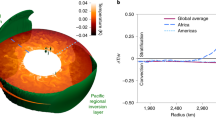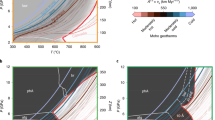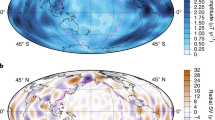Abstract
SEVERAL recent and apparently unrelated geophysical observations and deductions, when considered together, necessitate a fundamental re-examination of our ideas about the thermal state of the Earth's deep interior.
In summary they are:
(1) Precession must be discounted as a power source for the geomagnetic dynamo1, leaving core convection as the only plausible basic mechanism. Therefore the temperature gradient in the outer core cannot be less than adiabatic.
(2) The thermodynamic Grüneisen parameter for the outer core is about 1.4 and is only slightly pressure dependent (R. D. Irvine and F.D.S., unpublished).
(3) The resulting adiabatic gradient is much steeper than the Fe melting point gradient2 or the Fe–S eutectic gradient3.
(4) Continents and ocean floors are both mobile, although the ocean floors are much more so4, so that equality of the continental and oceanic heat fluxes which is observed5 (in spite of gross differences between the radioactive constituents of the continental and oceanic crusts) cannot be explained in terms of an association of depleted regions of the mantle with continents.
(5) Hot spots, across which the tectonic plates move, are not themselves moving perceptibly with respect to one another and are presumed to mark features of a rigid lower mantle4.
(6) A weak layer (asthenosphere) in the upper mantle allows virtually perfect isostatic balance of continent-sized blocks6 but the lower mantle must have greater strength. Low degree harmonic features of the geoid are supported by stresses at depths of several hundred kilometres7.
(7) Radiative transfer does not cause a dramatic increase in the thermal conductivity of mantle material at high temperatures8,9.
This is a preview of subscription content, access via your institution
Access options
Subscribe to this journal
Receive 51 print issues and online access
$199.00 per year
only $3.90 per issue
Buy this article
- Purchase on Springer Link
- Instant access to full article PDF
Prices may be subject to local taxes which are calculated during checkout
Similar content being viewed by others
References
Rochester, M. G., EOS (Trans. Am. geophys. Un.), 56, 1108 (1974).
Higgins, G., and Kennedy, G. C., J. geophys. Res., 76, 1870 (1971).
Tolland, H. G., Phys. Earth planet. Interiors, 8, 282 (1974).
Jordan, T. H., EOS (Trans Am. geophys. Un.), 56, 1102 (1974).
Lee, W. H. K., Phys. Earth planet. Interiors, 2, 332 (1970).
Stacey, F. D., Physics of the Earth (Wiley, New York, 1969).
Higbie, J., and Stacey, F. D., Phys. Earth planet. Interiors, 4, 145 (1970).
Fujisawa, H., Fujii, N., Mizutani, H., Kanamori, H., and Akimoto, S., J. Geophys. Res., 73, 4727 (1968).
Schatz, J. F., and Simmons, G., J. geophys. Res., 77, 6966 (1972).
Malkus, W. V. R., J. Geophys. Res., 68, 2871 (1963); Science, 160, 259 (1968).
Bullard, E., and Gubbins, D., Nature, 232, 548 (1971).
Kennedy, G. C., and Higgins, G. H., J. geophys. Res., 78, 900 (1973).
Stacey, F. D., Geophys. J. R. astr. Soc., 33, 47 (1973).
Elsasser, W. M., and Isenberg, I., Phys. Rev., 76, 469 (1949).
Sternheimer, R., Phys. Rev., 78, 235 (1950).
Dziewonski, A. M., Hales, A. L., and Lapwood, E. R., Phys. Earthplanet. Interiors (in the press).
Gardiner, R. B., and Stacey, F. D., Phvs. Earth planet. Interiors, 4, 406 (1971).
Stacey, F. D., Geophys. Surveys, 1, 99 (1972).
Morgan, W. J., Nature, 230, 42 (1971).
Metchnik, V. I., Gladwin, M. T., and Stacey, F. D., J. Geomag. Geoelect. (Kyoto) 26, 405 (1974).
Goles, G. G., in Handbook of Geochemistry, 1, (edit. by Wedepohl, K. H.), 116 (Springer, Berlin, 1969).
Lewis, J. S., Earth planet. Sci. Lett., 11, 130 (1971).
Hall, H. T., and Murthy, V. R., Earth planet. Sci. Lett., 11, 239 (1971).
Author information
Authors and Affiliations
Rights and permissions
About this article
Cite this article
STACEY, F. Thermal regime of the Earth's interior. Nature 255, 44–45 (1975). https://doi.org/10.1038/255044a0
Received:
Accepted:
Issue Date:
DOI: https://doi.org/10.1038/255044a0
This article is cited by
-
Applications of thermodynamics to fundamental earth physics
Geophysical Surveys (1977)
-
The Earth's deep interior
Die Naturwissenschaften (1976)
Comments
By submitting a comment you agree to abide by our Terms and Community Guidelines. If you find something abusive or that does not comply with our terms or guidelines please flag it as inappropriate.



